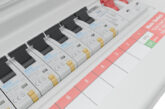
In this article, Jake Green, Head of Technical Engagement, Scolmore Group, considers where three- phase supplies come from and some of the general terms used. In subsequent articles Jake will consider fault currents, harmonics, triple-n harmonics and neutral conductors, as well as maximum demand and diversity.
It has long been recognised that it is more efficient and effective to generate three-phase supplies rather than single-phase supplies. Three-phase machinery is more efficient than its single-phase equivalent and three-phase supplies can deliver higher power more effectively than a single-phase arrangement.
Generation of three-phase
Typically, a three-phase supply is generated when a series of three-windings spaced 120° apart are rotated at 3,000 rpm (50 rps) within a magnetic field (Fig 1).

Fig 1 shows the DC supply to the rotor coils creating the magnetic field, whilst three windings (black, grey and brown) are set apart by 120°. As the coils are rotated within the alternator, the voltages generated within the windings will rise and fall as each passes the relative ‘north’ (N) and ‘south’ (S) of the magnetic field.
The generated voltage will be sinusoidal in shape (Fig 2) and the voltage will depend on the nature of the alternator but is typically in the region of 25 kV in the UK. This voltage is transformed up for transmission purposes and then transformed down for distribution to business and domestic consumers.

Irrespective of the level of voltage, the three phases remain constant, that is, separated by 120°.
Terminology
When considering anything to do with three-phase supplies, it is important that correct terminology is used. The labels for voltage and current vary because the relative relationships are different depending on what is being measured.

Delta connection
The start of one coil is connected to the end of the other into a closed loop. In delta-connected systems the line voltage and phase voltage are the same. For example, a 400 V line voltage is the same as the phase voltage. However, the relationship between line and phase currents differs by a factor of
For example, for a phase current of 10 A the line current would be:
This equation can be shown in a phasor diagram (Fig 4).

Star connection
The end points of each coil are connected to a common point (the neutral point). In star-connected systems the line current and phase current are the same. For example, a 13 A line current is a 13 A phase current. However, the relationship ! between line and phase voltages differs by a factor of
For example, a 230 V phase voltage means that the line voltage would be
This equation can be shown in a phasor diagram (Fig 5).

Supplies to premises
The final supply to premises is generally derived from a local distribution transformer and the connection at the transformer is in ‘star’.
The low-voltage side of the transformer allows for a series of single phase, split-phase (two-phase), or three phase supplies. Because the supply is star connected a neutral conductor is provided, and this conductor is connected to the general mass of Earth at the star point of the transformer (refer to Fig 6). The neutral is assumed to be at Earth potential (taken as 0 V).

Conclusion
This is a general introduction to three-phase systems. It is important to note that line and phase currents and voltages may have different values depending on whether the system is star or delta connected.
There are many questions which will need further consideration as they relate to the system described in Fig 6, such as: ‘What happens when single-phase loads have differing current values or the other loads are unbalanced? How much current will flow through the neutral conductor? What happens when harmonics are present on the neutral conductor?
These and other questions will be addressed in subsequent articles.
Browse the full Elucian circuit protection range here
Find more industry technical articles here








